 Facebook
Facebook
 X
X
 Instagram
Instagram
 TikTok
TikTok
 Youtube
Youtube
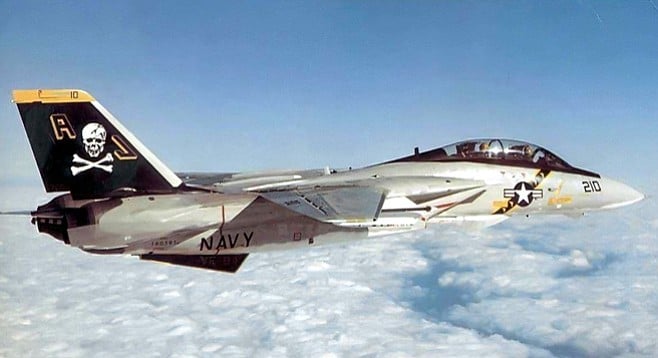
The dawn’s light is just beginning to angle through the mist to strike the cloud-colored F-14 fighter jet parked in a row in front of hangar three. The flight line at Miramar consists of 7 of the 14 jests belonging to the “Screaming Eagles” of VF-51, the oldest fighter squadron of continuous service in the Pacific. The jets loom in the half-light, with their canted, cloak like wings and their dual tail fins and their Cyclops canopies, dormant mechanical insects that have somehow molted out the Curtiss biplanes the squadron started with in 1927. A lone figure, the man on line watch who has been walking in circles around the planes since midnight moves slowly past the $35 million flying machines. All is quiet now, at 6:45 on a Tuesday morning. But not for long.
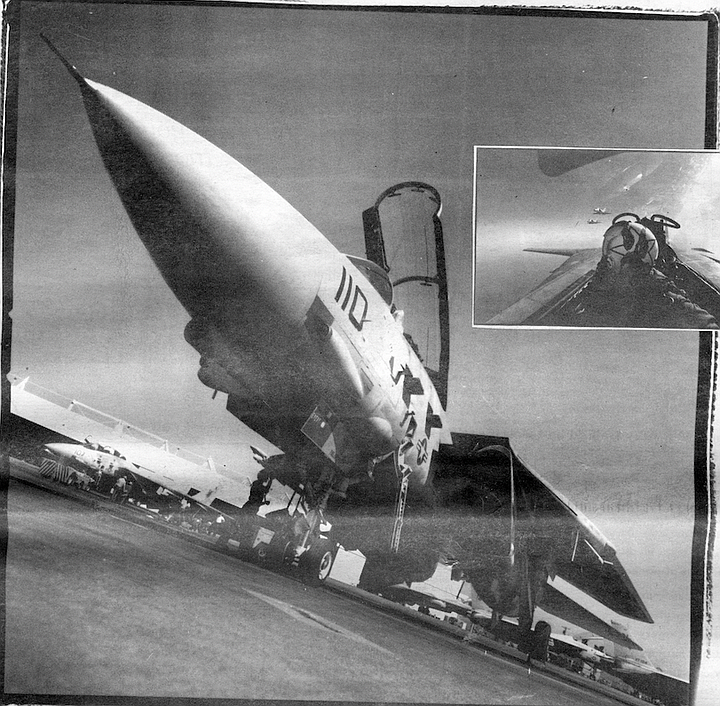
Inside the hangar, the 13 sailors on the day shift of VF-51’s line division are changing into their coveralls for another day of dirty work. The line division supervisor, Tony Gibbs, is checking on the posted plan of the day for the scheduled launch times of his airplanes. Gibbs, a 29-year-old first class petty officer, has charge of the biggest shop in the 250-man squadron: 26 sailors, most of them airmen, E-3s not long out of boot camp, about the lowest rank there is in the fleet. It’s also the youngest shop. Most of his charges are between 19 and 22. This where the plane captains work, the boys who have the most contact, on a daily basis, with the airplanes. It’s where the action and the danger is, especially on board ship, where their desk is the flight deck and their job is more perilous than a fighter pilot’s. “For young guys, the line is the place to be,” says Gibbs as his plane captains’ josh and grab ass and skylark. Here it is, 0-dark-30 in the morning, and the plane captains are behaving as if they’ve been up for hours.
A scowling chief petty officer pokes his puffy face around the corner and barks, “Why do I have to keep telling you guys to hold the /#&#@ noise down?” The line sailors look at each other, roll their eyes, and start whispering. Soon the grousing begins about the ‘/#&#@ old men” over there in the rest of the squadron. This division could not be called underconfident. “The whole squadron revolves around the line,” says one of Gibbs’s assistant supervisors. “If you’ve got a good line, you’ve got a good squadron.”
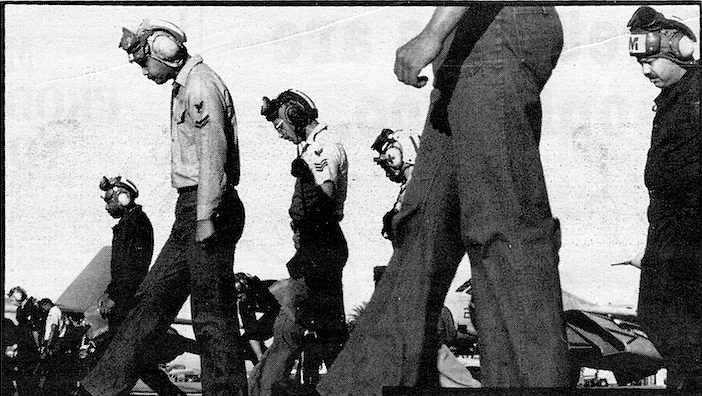
Gibbs has excused plane captain Billy Nawn from the morning’s “FOD walkdown” because his plane is due for an early launch. Every morning, about 40 members of every squadron at Miramar perform a ritual as old as the jet age. They start at the back of their hangar, facing the wall, and pick up every pebble, every scrap of string, wire, metal, cloth, plastic, anything lying between the wall of the hangar and the far end of the flight line, about 100 yards away from the tarmac. FOD (foreign object damage) is anything that can be sucked into a jet intake. Even the tiniest metal shavings are picked up by magnetic brooms pushed around the flight line by the airmen. The plan of the day says VF-51 has enjoyed 277 “FOD free days.” In other words, it’s been nine months since that wrench was sucked into one of their jet’s engines.
As the sailors on FOD walkdown inch out of the cavernous hangar, past F-14s in various stages of disassembly, and up one side of the planes and down the other, 20-year-old Billy Nawn ambles out to his sleeping bird. Nawn, who joined the Navy a week after graduating from high school in June of 1987, now owns F-14 Number 101, the plane he says is the best of the bunch. His friends back home in Mantua, New Jersey, can’t believe this is the same Billy they knew. “Before I joined up, I was one /#&#@ individual,” he says.
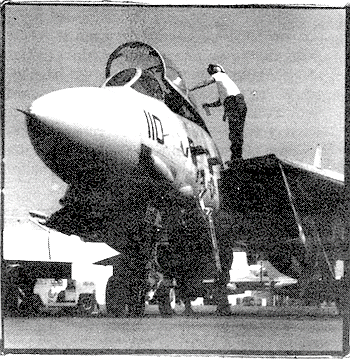
Plane captains get their names painted on their planes, just like the pilots and radar intercept officers (RIOs). The officers names are painted on the canopy frame, the plane captains’ on a panel that closes around the nose wheel. Nawn’s name and home town aren’t on 101 yet, he just claimed it as his plane about a month ago. It still carries the name and home town of Airman Jeff Lightner, Bethesda, Maryland, who happens to be the man on line watch now. As Nawn begins his preflight inspection, crouching under the nose of the jet and then standing up inside the nose wheel well to check the pressure on the brakes, the canopy, and the bottle of nitrogen used for blowing down the landing gear. Lightner walks up to watch.
“This has always been a good bird,” he says. “It was always ‘up.’” Lightner has been transferred out of the line division to another shop within the squadron. He watches longingly as Nawn moves with deliberate dispatch through the preflight inspection. “I miss some parts of being a PC, like launching the bird, especially on cruises, but I don’t miss washing it.” On shore, the planes are washed every 14 days; at sea, every 7 days. “But I wiped it down every day, before every launch, it had my name on it, it’s representing me.” Some plane captains go so far as to touch up the white-lettering in the “Goodyear” branded on the tires. They’ve been known to become especially proprietary about their jets when midshipmen from Annapolis puke all over the back seat during the cadets’ introduction to naval aviation. Most plane captains insist that the midshipmen clean up their own messes.
Nawn pulls the cockpit ladder out of a hidden panel, revealing the cartridge chain (unloaded) that carries the 675 rounds of 20mm bullets to the canon imbedded on the left side of the plane’s nose. The FOD walkdown has started back toward the hangar, behind the flight line, as Nawn is crawling into the portside air intake. In Navy lingo, he’s “duct-diving,” inspecting the inside of the engine gullets, a job for which he had to pass a written exam to qualify. Sailors boast that Air Force ground crewmen get hazardous pay for such a task, while they, the ballsy Navy men, do it for free.
At about 7:30, Commander Bob “Rat” Willard, Annapolis ’73, the executive officer (second in command) of VF-51, strides out to the plane wearing his flight suit, harness, G-suit, survival vest, and helmet. His RIO, wearing the same garb, is close behind, and both men move quietly around the jet doing the same preflight checks as the plane captain, throwing in a few yanks, twists, pats and pulls of their own. Willard, who helped choreograph the aerial combat scenes in the movie Top Gun and also appeared in the film as the black-clad Rooskie flying the MiG, is considered by his peers to be one of the best fighter pilots in the Navy. Steely but amiable, coiled but relaxed, Willard carries himself with that rock-ribbed confidence essential to fighter pilots. His bearing suggests the institutional memory of a squadron whose pilot roster once included future astronauts Neil Armstrong and Ron Evans, as well as Admiral James B. Stockdale (Ret). The admiral, who was awarded the Medal of Honor for his leadership while incarcerated for seven years as a POW in North Vietnam, was flying an F-8 Crusader as commanding officer of the VF-51 over the Gulf of Tonkin that August night in 1964, when a putative attack by torpedo boats against the USS Maddox gave Congress its excuse to declare undeclared war against North Vietnam.
Willard climbs up into the cockpit and Nawn follows. The plane captain helps the pilot strap the plane on and assists him in hooking up his oxygen hose. Seemingly from out of nowhere, two troubleshooters have materialized and are hustling around the plane, closing panels and checking gauges. Off to one side stands Tony Gibbs, watching impassively as his men prepare to start the Tomcat’s engines. The jet next to Nawn’s is already turning up, and troubleshooters are brachiating about like spider monkeys, avoiding the intakes and the exhaust, ducking under fins, crab-walking beneath the breast of the bird. A piece of ground equipment called a “huffer” is moved into position beside Nawn’s plane, and its hose is plugged into the jet’s belly to start pushing air through the port engine. Using a series of hand signals, Nawn commands Commander Willard to start one engine, then the other. Then he signals the pilot through preflight tests of the plane’s control surfaces. The troubleshooters push and pull on the slats that drop down from the leading edge of the wings, and they notice that a spoiler on the rear of one wing won’t rotate up. One of the ‘shooters plugs in a communication line under the nose and talks to the pilot about the problem. Willard checks a circuit breaker, and the spoiler starts working. When the ‘shooters all signal that everything looks okay to them, Nawn signals for the chocks to be pulled from in front of the wheels, then he commands the pilot to begin slowly moving the screaming jet out onto the taxiway. When the plane is clear of the line and moving toward the runway, the plane captain salutes the pilot and walks back toward the hangar, the warm jet blast rolling over his back. What’s he going to do now? “Nothing, I hope,” he chuckles.
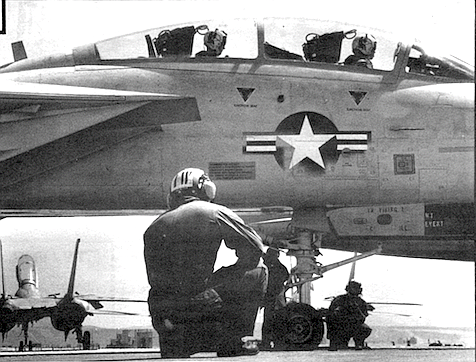
On shore, plane captains and their F-14s are marking time away from their real mission: providing carrier battle groups (about 13 ships) with long-range, outer air protection against incoming attack. In contrast to the plane it replaced, the F-4 Phantom, which did double duty as a fighter/bomber during the Vietnam War, the F-14 is used strictly in a defensive role as an interceptor carrying Sidewinder, Sparrow, and Phoenix air-to-air missiles. Unlike their East Coast counterparts, whose sea duty includes cruising the Mediterranean, West Coast squadrons generally find themselves cruising the Pacific, so they don’t have countries like Libya or Iran to worry about. The chances that a West Coast-based F-14 (all of which are stationed at Miramar) will end up in a dogfight with a Soviet-made MiG are considered slim. “Most of the MiGs in the Pacific are flown by Soviet pilots, and they’re too disciplined to get into tussles with us,” remarks one VF-51 aviator, referring to recent encounters over the Mediterranean in which F-14s have shot down Libyan fighters. The Russians are better poker players, and sometimes they bring the game to the American’s table. A Russian spy ship is frequently cruising off the coast of Southern California, monitoring the aerial combat maneuvering exercises of Miramar-based fighters, and its presence sometimes determines the type of training the pilots can do. For instance, if the ship is found to be monitoring the Navy’s air-to-air missile range of Santa Catalina Island, scheduled missile shooting practice is canceled.
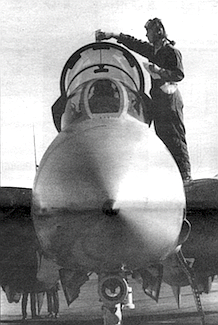
After VF-51 and the rest of Air Wing 15 (which includes two fighter squadrons, three attack squadrons, an electronic countermeasures squadron, and a helicopter squadron) left San Francisco aboard the aircraft carrier Carl Vinson on June 15, 1988, they headed north to the Aleutians, where the F-14s played their usual games with Russian MiGs and bombers: VF-51 pilots shot excellent video of the Soviet planes on patrol while their Russian counterparts took pictures of the Tomcats (The Russian pilots probably never imagined that these pictures would eventually be shown at squadron parties in San Diego before the throngs of young women who gravitate to the American fighter jocks). After a few days of making its presence known near the northeastern edge of the Soviet Union, the ship turned southwest, passing through the Japanese archipelago and the Sea of Japan, and landing in Subic Bay, just north of Olongapo City in the Philippines, one of the most famous liberty ports in the world. About 90 of the enlisted men in VF-51 were on their first cruise, and most of them hit the beach hungry to make real all the sea stories they’d heard about ‘Po City.
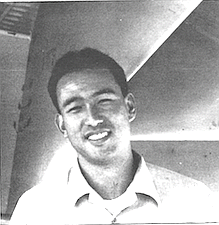
Billy Nawn, being single, wasted no time hiring a girl there for two days. Most of the other plane captains did the same, since this was more cost effective than switching girlfriends every night. An airman only makes $850 a month, plus $110 extra for flight-deck pay. “She’d just meet me at the gate (of the Subic Bay naval base), and I’d give her my money.” Nawn relates, “She knew where to go to get drinks for half price.”
During the day, many of the sailors and officers stayed on the base to compete in the battle group’s big softball tournament. The squadron’s joint officer/enlisted team, which played games throughout the Western Pacific, became the terror of the seas. The VF-51 squad won the tournament in Subic Bay without the help of any of the plane captains, who had other interests.
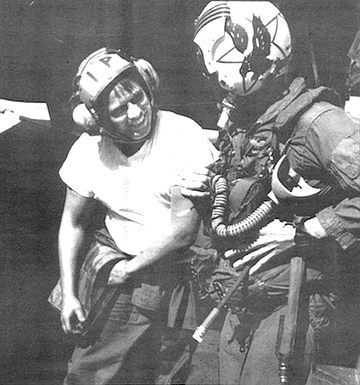
On the next to last night in ’Po City, a prostitute stole the wallet of plane captain Jim Snow of Philadelphia. It contained his money and his sacred military ID card. Sailors are told that if you lose your ID, it’s automatic “captain’s mast,” a form of nonjudicial punishment. But this time, Master Chief Dan Oakley, the most senior enlisted man in the squadron (28 years of experience stretching back to the beginning of the Vietnam War), nicknamed Uncle Festus by the plane captains, stretched the rules a bit. Chief Oakley took Snow into the sprawling Navy base at Subic, and the young sailor had a new ID card the next night. “That was one of the best things that happened to me the whole cruise,” says Snow, not counting the Tasmanian devil he had tattooed onto his left calf in Hawaii.
One of the worst things that happened was getting his underwear stolen on board the ship while he took a shower. “Can you believe somebody would steal your underwear?” he marvels, more upset about that than the loss of his wallet. “That’s how bad it gets out here sometimes.”
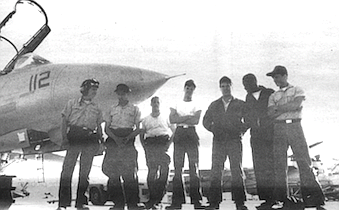
After four days in the P.I., the ship headed southwest across the South China Sea and put in at Singapore, which the plane captains found too expensive and strict. “You couldn’t even spit on the sidewalk there,” Nawn observes. Three days later, the Vinson eased through the Strait of Malacca and entered the Indian Ocean, where it would remain on station for 87 days.
Nowadays, the Navy keeps a carrier battle group on station in the IO pretty much full time. The presence of serious firepower near the entrance to the Persian Gulf is supposed to have a calming effect on that volatile region. For the veterans of previous cruises, this was actually the shortest length of stay in the IO, but for most of the plane captains, 87 days was an eternity. It was 110 degrees on the flight deck some days, not including the jet blast factor. Normally, the JP-5 jet fuel that formed little slicks on top of their grape juice in the galley didn’t bother the airmen, but after three straight months without liberty, it was no longer funny. Their long, dangerous days on the flight deck were broken up by wrestling matches with the line division of their sister squadron, VF-111, and the administering of pink bellies to new arrivals. The constant competition to see who could get his bird ready for the catapult first – a manifestation of the need to be able to launch airplanes quickly in order to defend the ship – kept the monotony at bay, as did the knowledge that any one of them could die any minute.
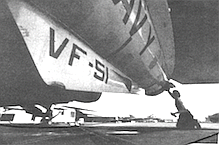
A major part of line division supervisor Tony Gibbs’s job is making sure his men know how fleeting life can be on the flight line. “They’ve heard all the sea stories,” he says, “and most of mine are true.” Gibbs is too young to know firsthand the one about the crippled F-8 Crusader that crashed into the hangar at Miramar three days before Christmas in 1969, killing 11 sailors. And he was still in elementary school on July 29, 1967, the day of the legendary blaze that nearly sank the aircraft carrier Forrestal off the coast of Vietnam. But he and his plane captains are well acquainted with that catastrophe: it began when hot exhaust from a huffer ignited a missile under the wing of a jet. The missile shot across the flight deck, which was crowded with planes fueled and armed for an attack on North Vietnam, and struck a fuel tank on another jet. The ensuing explosion set off a chain reaction of unspeakable destruction. Thousand pound bombs began exploding on deck, along with missiles and fuel tanks. Men with burning clothes leaped over the side, and many of them were never found. Several jets were pushed into the sea. When it was over several hours later, more than 100 men were dead, dozens were missing, and 90 were injured.
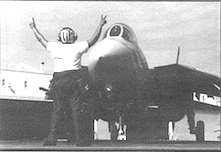
Gibbs himself has witnessed gruesome mishaps at sea, accidents as bad as the one in the training film showing an airman getting his legs cut off by an arresting cable that snapped during a jet’s landing and started whipping the flight deck. Gibbs was on the flight deck in 1987 when a troubleshooter in an attack squadron was blown by one jet’s exhaust into the jet blast of another plane, which shot him through the air “like a rag doll.” He flew over two airplanes and then over the side of the aircraft carrier into the sea. Though he was rescued, he later died.
“They got walking blood banks on board ship,” Gibbs explains. “They call your number, you drop what you’re doing and go give blood.” This blood supply came in handy on another cruise in 1987, when Gibbs witnessed a chief ordinanceman get his legs crushed under the wheels of a taxiing jet. Airman Linear Vining, a plane captain with one cruise under his belt, has his own way of describing the lurking mayhem of the flight line: “If your mind is over here and your ass is over there, your ass might stay over there for good.”

After the first 45 days in the Indian Ocean, each man on the Vinson was issued tickets to claim his two beers. Nothing exotic, just Miller or Bud, but it tasted like ambrosia to the plane captains. After that, the next 42 days seemed like forever before the ship dropped anchor of Mombasa, Kenya.
By the time they reached Africa, the sailors had heard so many lectures warning of the dangers of AIDS that “I was wearing two rubbers,” says Airman Snow. Several of the plane captains checked into a beachfront hotel, a base from which they took short safaris and made shopping sorties into the small town. The chiefs and officers did the same, many of them traveling for seven hours on safari to a hunting lodge at the base of Mt. Kilimanjaro. Nine of the squadron’s officers went on a game drive in a wildlife preserve called Amboseli. “There were literally millions of animals, for as far as you could see,” recalls Lieutenant Commander Tom Joyce. “Zebras, elephants, wildebeest, everybody was stunned into silence. It was truly awesome.”
In town Nawn traded a phony Rolex watch to the extremely friendly natives for clothes and jewelry. Some plane captains used flight-deck T-shirts and ballpoint pens as barter. On one two-day safari taken by many of the plane captains, Airman Dave Peterson of Wisconsin drank too much beer and fell asleep in a comfortable spot on the ground, his buddies started throwing pieces of bread over him to attract the monkeys. Until he saw the snapshots, Petey didn’t believe that he had had monkeys climbing all over him.
After five days in Africa, the ship spent 18 days at sea, then stopped at Pattaya Beach, Thailand. Master Chief Oakley made sure his men knew that drugs would be too easily available here and that previous battle groups had had sailors killed in this port. While a few of the plane captains headed for Bangkok, where they visited the temples and dodged the Japanese sex tours, most stayed on the beach to shop for precious stones and women. Nawn and Snow found this to be the best liberty of the entire cruise.
Of course, there were the sex shows, where women pulled razor blades on a string out of their vaginas or stuck blowguns between their legs to shoot darts at balloons on the ceiling. And then there were the massage parlors, where the women lounged behind a glass partition wearing numbers. Snow picked his plane number 110, the plane he calls the workhorse of the squadron, “and luckily, she was good looking.” (Snow did have a girlfriend back home in Philadelphia, but she got married to someone else while he was at sea. He still fumes that “the cunt sold my ring.” Nawn had a girlfriend in San Diego for a while, “But I smelt relationship all over her. No way, man, no way!”) Snow was surprised one night in Thailand to find himself entwined with a woman while Nawn and another prostitute fell onto the mattress in the same room. They chuckle uncomfortably that they even shared the same women – on successive nights – in Singapore and the Philippines.
And so it went. By the time the ship reached Hong Kong, Nawn had blown all his money. The plane captains found it odd that in nearly every club they visited in the Suzi Wong district of Hong Kong, there was a fight between the Americans and British tourists. “There were five fights in 20 minutes in the Tomcat Lounge,” says Nawn. This may have had something to do with the inflated prices – almost four dollars for a cup of coffee, five dollars for a beer in some places – but it was probably more attributable to the paucity of women in the bars and that the ones that were there didn’t seem to like Yanks.
While other members of the squadron, married guys and those with girlfriends back home, shopped for electronics or visited Victoria Peak or the floating restaurants, Nawn grew tired of the bar fights. He hopped on a subway to he-knew-not-where and ended up the only foreigner way out in the suburbs of Hong Kong. As he walked past elementary schools that looked as though they’d been bombed out in World War II and not repaired, the schoolchildren stared quizzically at the lone American.
On the way back to San Francisco, the ship passed through Olongapo City once again, then stopped briefly in Pearl Harbor. Here the Vinson picked up its “taggers,” civilian family members of the crew, for the eight-day trip back to the U.S. VF-51 had 42 taggers. Nawn’s father got to watch his son on the flight deck from a safe perch above the action. “He couldn’t believe it,” Nawn beams proudly. “He was freaking!”
The Chief
Master Chief Dan Oakley has an office upstairs in hangar three at Miramar, just down the hall from the officers’ ready room. Oakley exudes the kind of seen-it-all worldliness unique to senior Navy enlisted men. His job as command master chief is to be the cog between the skipper of the squadron, Commander G.A. Stevens, and the enlisted men. Unofficially, however, Oakley sees himself and the other 15 chiefs in the squadron as the force that trains the junior officers to be leaders. He believes the old adage that says it’s the chiefs who run the Navy.
Oakley began to learn these leadership skills as a gunner in UH-1 helicopters in Vietnam. He won the Distinguished Flying Cross during the TET offensive of 1968. After the war, he spent most of the next 20 years in patrol squadrons and helicopter squadrons. VF-51, which he joined in January of 1987, is his first fighter squadron.
Oakley says most Navy squadrons, whatever aircraft they’re flying, are organized essentially the same way. That is to say, the heart of the squadron is the maintenance division. Unlike Air Force squadrons, and indeed most aircraft squadrons throughout the world, Navy squadrons take on the task of fixing their own planes. An Air Force squadron is a small cadre of pilots and the few enlisted men needed to get the planes off the ground, but the planes don’t belong to the squadron. The pilots check out their planes from a centralized maintenance command that has charge of an entire air wing’s airplanes. In contrast, Navy squadrons are independent entities in which officers have major responsibilities outside of flying. The officers who stay in the Navy and win major assignments, such as command of an aircraft carrier, have learned their administrative skills as operations officers, maintenance officers, and other management-level assignments in their squadrons.
Oakley says the main difference between a fighter squadron and the other squadrons he’s been in is one of pace. “Here, everything we do is on the run,” he explains. “We launch one of these babies, and we expect it back in an hour, then turn it around and get it ready to launch again. You launch a helicopter, it’s gone for 4 hours; a P-3 (patrol plane) is out for 4 to 12 hours.”
One of Oakley’s chief concerns is squadron morale. He says VF-51’s overall morale is high now, between deployments, because of an attitude change that took 18 months to instill. “Before, we were working 8 to 12 hour days, including weekends, and that’s hard on people. Now we’ve shifted it so they work 8 hours, and the weekends are sacred. On shore, you want to allow as much time for wives and girlfriends as you possibly can. All of the chiefs have convinced their supervisors to work their people smarter and get the work done in 8 hours.”
After launching his plane on that early morning in mid-March, Billy Nawn heads back toward the line shack door in the rear of the hangar. Just as he reaches to open the door, three plane captains come rushing out, moaning and holding their noses and pointing fingers. Somebody has cut one, and nobody will take credit. Inside, Tony Gibbs is doing paperwork and giving out work assignments. Plane captain trainees are to be studying various publications and safety manuals, preparing for the battery of tests they must pass before they’re given the responsibility for a plane on the line. The plane captains who have launched their birds work on their collateral duties, such as keeping track of the division’s tools or updating the Navy publications and manuals in the division’s substantial library. Other PCs are away in training seminars elsewhere on the base.
Nawn’s roommate in the barracks at Miramar, Airman Jim Snow is at NADSAP, a week-long drug, alcohol, and stress-reduction seminar that each enlisted man must attend before he’s given a gate sticker for his car or motorcycle. Nawn says by the third day of the stress seminar, “I was so stressed out I couldn’t stand it.” Later, Snow will describe the course as a “bunch of psychobabble.” The sailors lay claim, with relish, to the ancient tradition of cracking wise about Navy efforts to influence their good character (in the early 1970s, in the wake of race riots aboard the aircraft carrier Kitty Hawk, the race-relations seminars set up by the Navy were widely termed “Nigger School” by sailors) but beneath the hard-bitten veneer, they have no doubts about the Navy’s seriousness in combatting drugs. Random drug testing is mandatory for all Navy personnel: one man in the line shack says his urine has been tested four times since last November.
The stated drug policy of VF-51, and most other Navy commands, is zero tolerance. “If they get a drug hit, I tell them I’ll personally walk them to the gate,” asserts Master Chief Oakley. He says two of his men are in the process now of being “ad-sepped” administratively separated from the Navy for drug hits, which will bring the total to eight released for drugs since Oakley arrived at VF-51 a little over two years ago.
Publicly, the Navy wants to project the image of being totally committed to an unyielding anti-drug policy. But in reality, sailors say that plenty of marijuana and other drugs existed on board the aircraft carrier Carl Vinson during the last cruise. They also say the zero-tolerance policy doesn’t apply to all sailors. Whether or not you’re run out of the service for a positive drug test “depends on who you know,” explains one lower enlisted man. “I know a few people that got popped in urinalysis, and it never showed up on their record.” Underneath all the drug bluster, the Navy is evidently willing to ignore the indiscretions of certain sailors who have demonstrated talent and ability.
But compared to the young sailors of the early 1970s, VF-51’s plane captains seem to have zero interest in drugs. The line division is where most of the squadron’s newly arrived sailors are first assigned, and it is where their reputations are formed. After spending about 18 months on the line, the plane captains are then transferred into their particular job specialty, such as the power plant shop, airframes, the ejection seats, or the parachute riggers’ shop. So there’s incentive to do well, both in order to get out of the line sooner and to create the momentum of a good reputation.
It is these boys, the E-3 airmen and the E-4 third class petty officers who do most of the actual work on the airplanes. They have a saying in fighter squadrons: “it takes a college degree to break an F-14, and a high school diploma to fix it.”
“It’s true,” says Lieutenant Commander Tom Joyce, the squadron’s operations officer. “The worker bees are 18, 19 years old. The first-class petty officers are the overall supervisors. There’s just an incredible amount of documentation that goes with maintaining these airplanes, and most of that is handled by the senior petty officers.” Does the fact that the planes are being fixed and handled by kids barely out of adolescence give him pause when he climbs into the back seat of his jet? “Not at all. If they’re not doing their job, it shows. It’s very clear. Everything is checked and double-checked.”
The plane captains have a little bit different perspective on this. “If it wasn’t for us, there wouldn’t be a Navy,” says one airman. “On board ship, the E-3s and below do most of the work in every area, and the majority of the people on the ship are airmen. That’s the way the Navy works, man. If something goes wrong, the higher ups can always blame it on an airman.”
Line division supervisor Tony Gibbs, a nine-year Navy veteran who has visited 20 nations around the globe, has just lost his main assistant supervisor to the power plants shop. He too, is due for rotation out of the line, but his superiors don’t have another first class who can replace him. Actually, he’s filling a billet designated for an E-8 chief, two grades above a first class, so preliminary plans to move him to a maintenance shop have been scrapped, because it would be a demotion. Highly respected within the squadron, Gibbs will have to stay put for a while, though his superiors know he’s getting restless. He’s applied to become an officer. If he doesn’t gain entrance to the program, he’s considering leaving the Navy.
In mid-March, Gibbs appoints two of his plane captains, Linear Vining and William Johnson, to compete for the job of assistant supervisor. Vining, a competent and funny 22-year-old from Chicago who also claims to have the best bird (number 114) on the line remarks, “I wanted to go on to my shop, but then this job opportunity opened up, so I’m going for it. I been in the line for about a year and a three months. I need to take on a little more responsibility around here.” About a week later, Gibbs announced that instead of choosing one of them, both Johnson and Vining would hold the position of assistant supervisor. “That’s so when everybody starts hating us,” Vining cracks, “at least we’ll have each other to talk to.”


The dawn’s light is just beginning to angle through the mist to strike the cloud-colored F-14 fighter jet parked in a row in front of hangar three. The flight line at Miramar consists of 7 of the 14 jests belonging to the “Screaming Eagles” of VF-51, the oldest fighter squadron of continuous service in the Pacific. The jets loom in the half-light, with their canted, cloak like wings and their dual tail fins and their Cyclops canopies, dormant mechanical insects that have somehow molted out the Curtiss biplanes the squadron started with in 1927. A lone figure, the man on line watch who has been walking in circles around the planes since midnight moves slowly past the $35 million flying machines. All is quiet now, at 6:45 on a Tuesday morning. But not for long.

Inside the hangar, the 13 sailors on the day shift of VF-51’s line division are changing into their coveralls for another day of dirty work. The line division supervisor, Tony Gibbs, is checking on the posted plan of the day for the scheduled launch times of his airplanes. Gibbs, a 29-year-old first class petty officer, has charge of the biggest shop in the 250-man squadron: 26 sailors, most of them airmen, E-3s not long out of boot camp, about the lowest rank there is in the fleet. It’s also the youngest shop. Most of his charges are between 19 and 22. This where the plane captains work, the boys who have the most contact, on a daily basis, with the airplanes. It’s where the action and the danger is, especially on board ship, where their desk is the flight deck and their job is more perilous than a fighter pilot’s. “For young guys, the line is the place to be,” says Gibbs as his plane captains’ josh and grab ass and skylark. Here it is, 0-dark-30 in the morning, and the plane captains are behaving as if they’ve been up for hours.
A scowling chief petty officer pokes his puffy face around the corner and barks, “Why do I have to keep telling you guys to hold the /#&#@ noise down?” The line sailors look at each other, roll their eyes, and start whispering. Soon the grousing begins about the ‘/#&#@ old men” over there in the rest of the squadron. This division could not be called underconfident. “The whole squadron revolves around the line,” says one of Gibbs’s assistant supervisors. “If you’ve got a good line, you’ve got a good squadron.”

Gibbs has excused plane captain Billy Nawn from the morning’s “FOD walkdown” because his plane is due for an early launch. Every morning, about 40 members of every squadron at Miramar perform a ritual as old as the jet age. They start at the back of their hangar, facing the wall, and pick up every pebble, every scrap of string, wire, metal, cloth, plastic, anything lying between the wall of the hangar and the far end of the flight line, about 100 yards away from the tarmac. FOD (foreign object damage) is anything that can be sucked into a jet intake. Even the tiniest metal shavings are picked up by magnetic brooms pushed around the flight line by the airmen. The plan of the day says VF-51 has enjoyed 277 “FOD free days.” In other words, it’s been nine months since that wrench was sucked into one of their jet’s engines.
As the sailors on FOD walkdown inch out of the cavernous hangar, past F-14s in various stages of disassembly, and up one side of the planes and down the other, 20-year-old Billy Nawn ambles out to his sleeping bird. Nawn, who joined the Navy a week after graduating from high school in June of 1987, now owns F-14 Number 101, the plane he says is the best of the bunch. His friends back home in Mantua, New Jersey, can’t believe this is the same Billy they knew. “Before I joined up, I was one /#&#@ individual,” he says.

Plane captains get their names painted on their planes, just like the pilots and radar intercept officers (RIOs). The officers names are painted on the canopy frame, the plane captains’ on a panel that closes around the nose wheel. Nawn’s name and home town aren’t on 101 yet, he just claimed it as his plane about a month ago. It still carries the name and home town of Airman Jeff Lightner, Bethesda, Maryland, who happens to be the man on line watch now. As Nawn begins his preflight inspection, crouching under the nose of the jet and then standing up inside the nose wheel well to check the pressure on the brakes, the canopy, and the bottle of nitrogen used for blowing down the landing gear. Lightner walks up to watch.
“This has always been a good bird,” he says. “It was always ‘up.’” Lightner has been transferred out of the line division to another shop within the squadron. He watches longingly as Nawn moves with deliberate dispatch through the preflight inspection. “I miss some parts of being a PC, like launching the bird, especially on cruises, but I don’t miss washing it.” On shore, the planes are washed every 14 days; at sea, every 7 days. “But I wiped it down every day, before every launch, it had my name on it, it’s representing me.” Some plane captains go so far as to touch up the white-lettering in the “Goodyear” branded on the tires. They’ve been known to become especially proprietary about their jets when midshipmen from Annapolis puke all over the back seat during the cadets’ introduction to naval aviation. Most plane captains insist that the midshipmen clean up their own messes.
Nawn pulls the cockpit ladder out of a hidden panel, revealing the cartridge chain (unloaded) that carries the 675 rounds of 20mm bullets to the canon imbedded on the left side of the plane’s nose. The FOD walkdown has started back toward the hangar, behind the flight line, as Nawn is crawling into the portside air intake. In Navy lingo, he’s “duct-diving,” inspecting the inside of the engine gullets, a job for which he had to pass a written exam to qualify. Sailors boast that Air Force ground crewmen get hazardous pay for such a task, while they, the ballsy Navy men, do it for free.
At about 7:30, Commander Bob “Rat” Willard, Annapolis ’73, the executive officer (second in command) of VF-51, strides out to the plane wearing his flight suit, harness, G-suit, survival vest, and helmet. His RIO, wearing the same garb, is close behind, and both men move quietly around the jet doing the same preflight checks as the plane captain, throwing in a few yanks, twists, pats and pulls of their own. Willard, who helped choreograph the aerial combat scenes in the movie Top Gun and also appeared in the film as the black-clad Rooskie flying the MiG, is considered by his peers to be one of the best fighter pilots in the Navy. Steely but amiable, coiled but relaxed, Willard carries himself with that rock-ribbed confidence essential to fighter pilots. His bearing suggests the institutional memory of a squadron whose pilot roster once included future astronauts Neil Armstrong and Ron Evans, as well as Admiral James B. Stockdale (Ret). The admiral, who was awarded the Medal of Honor for his leadership while incarcerated for seven years as a POW in North Vietnam, was flying an F-8 Crusader as commanding officer of the VF-51 over the Gulf of Tonkin that August night in 1964, when a putative attack by torpedo boats against the USS Maddox gave Congress its excuse to declare undeclared war against North Vietnam.
Willard climbs up into the cockpit and Nawn follows. The plane captain helps the pilot strap the plane on and assists him in hooking up his oxygen hose. Seemingly from out of nowhere, two troubleshooters have materialized and are hustling around the plane, closing panels and checking gauges. Off to one side stands Tony Gibbs, watching impassively as his men prepare to start the Tomcat’s engines. The jet next to Nawn’s is already turning up, and troubleshooters are brachiating about like spider monkeys, avoiding the intakes and the exhaust, ducking under fins, crab-walking beneath the breast of the bird. A piece of ground equipment called a “huffer” is moved into position beside Nawn’s plane, and its hose is plugged into the jet’s belly to start pushing air through the port engine. Using a series of hand signals, Nawn commands Commander Willard to start one engine, then the other. Then he signals the pilot through preflight tests of the plane’s control surfaces. The troubleshooters push and pull on the slats that drop down from the leading edge of the wings, and they notice that a spoiler on the rear of one wing won’t rotate up. One of the ‘shooters plugs in a communication line under the nose and talks to the pilot about the problem. Willard checks a circuit breaker, and the spoiler starts working. When the ‘shooters all signal that everything looks okay to them, Nawn signals for the chocks to be pulled from in front of the wheels, then he commands the pilot to begin slowly moving the screaming jet out onto the taxiway. When the plane is clear of the line and moving toward the runway, the plane captain salutes the pilot and walks back toward the hangar, the warm jet blast rolling over his back. What’s he going to do now? “Nothing, I hope,” he chuckles.

On shore, plane captains and their F-14s are marking time away from their real mission: providing carrier battle groups (about 13 ships) with long-range, outer air protection against incoming attack. In contrast to the plane it replaced, the F-4 Phantom, which did double duty as a fighter/bomber during the Vietnam War, the F-14 is used strictly in a defensive role as an interceptor carrying Sidewinder, Sparrow, and Phoenix air-to-air missiles. Unlike their East Coast counterparts, whose sea duty includes cruising the Mediterranean, West Coast squadrons generally find themselves cruising the Pacific, so they don’t have countries like Libya or Iran to worry about. The chances that a West Coast-based F-14 (all of which are stationed at Miramar) will end up in a dogfight with a Soviet-made MiG are considered slim. “Most of the MiGs in the Pacific are flown by Soviet pilots, and they’re too disciplined to get into tussles with us,” remarks one VF-51 aviator, referring to recent encounters over the Mediterranean in which F-14s have shot down Libyan fighters. The Russians are better poker players, and sometimes they bring the game to the American’s table. A Russian spy ship is frequently cruising off the coast of Southern California, monitoring the aerial combat maneuvering exercises of Miramar-based fighters, and its presence sometimes determines the type of training the pilots can do. For instance, if the ship is found to be monitoring the Navy’s air-to-air missile range of Santa Catalina Island, scheduled missile shooting practice is canceled.

After VF-51 and the rest of Air Wing 15 (which includes two fighter squadrons, three attack squadrons, an electronic countermeasures squadron, and a helicopter squadron) left San Francisco aboard the aircraft carrier Carl Vinson on June 15, 1988, they headed north to the Aleutians, where the F-14s played their usual games with Russian MiGs and bombers: VF-51 pilots shot excellent video of the Soviet planes on patrol while their Russian counterparts took pictures of the Tomcats (The Russian pilots probably never imagined that these pictures would eventually be shown at squadron parties in San Diego before the throngs of young women who gravitate to the American fighter jocks). After a few days of making its presence known near the northeastern edge of the Soviet Union, the ship turned southwest, passing through the Japanese archipelago and the Sea of Japan, and landing in Subic Bay, just north of Olongapo City in the Philippines, one of the most famous liberty ports in the world. About 90 of the enlisted men in VF-51 were on their first cruise, and most of them hit the beach hungry to make real all the sea stories they’d heard about ‘Po City.

Billy Nawn, being single, wasted no time hiring a girl there for two days. Most of the other plane captains did the same, since this was more cost effective than switching girlfriends every night. An airman only makes $850 a month, plus $110 extra for flight-deck pay. “She’d just meet me at the gate (of the Subic Bay naval base), and I’d give her my money.” Nawn relates, “She knew where to go to get drinks for half price.”
During the day, many of the sailors and officers stayed on the base to compete in the battle group’s big softball tournament. The squadron’s joint officer/enlisted team, which played games throughout the Western Pacific, became the terror of the seas. The VF-51 squad won the tournament in Subic Bay without the help of any of the plane captains, who had other interests.

On the next to last night in ’Po City, a prostitute stole the wallet of plane captain Jim Snow of Philadelphia. It contained his money and his sacred military ID card. Sailors are told that if you lose your ID, it’s automatic “captain’s mast,” a form of nonjudicial punishment. But this time, Master Chief Dan Oakley, the most senior enlisted man in the squadron (28 years of experience stretching back to the beginning of the Vietnam War), nicknamed Uncle Festus by the plane captains, stretched the rules a bit. Chief Oakley took Snow into the sprawling Navy base at Subic, and the young sailor had a new ID card the next night. “That was one of the best things that happened to me the whole cruise,” says Snow, not counting the Tasmanian devil he had tattooed onto his left calf in Hawaii.
One of the worst things that happened was getting his underwear stolen on board the ship while he took a shower. “Can you believe somebody would steal your underwear?” he marvels, more upset about that than the loss of his wallet. “That’s how bad it gets out here sometimes.”

After four days in the P.I., the ship headed southwest across the South China Sea and put in at Singapore, which the plane captains found too expensive and strict. “You couldn’t even spit on the sidewalk there,” Nawn observes. Three days later, the Vinson eased through the Strait of Malacca and entered the Indian Ocean, where it would remain on station for 87 days.
Nowadays, the Navy keeps a carrier battle group on station in the IO pretty much full time. The presence of serious firepower near the entrance to the Persian Gulf is supposed to have a calming effect on that volatile region. For the veterans of previous cruises, this was actually the shortest length of stay in the IO, but for most of the plane captains, 87 days was an eternity. It was 110 degrees on the flight deck some days, not including the jet blast factor. Normally, the JP-5 jet fuel that formed little slicks on top of their grape juice in the galley didn’t bother the airmen, but after three straight months without liberty, it was no longer funny. Their long, dangerous days on the flight deck were broken up by wrestling matches with the line division of their sister squadron, VF-111, and the administering of pink bellies to new arrivals. The constant competition to see who could get his bird ready for the catapult first – a manifestation of the need to be able to launch airplanes quickly in order to defend the ship – kept the monotony at bay, as did the knowledge that any one of them could die any minute.

A major part of line division supervisor Tony Gibbs’s job is making sure his men know how fleeting life can be on the flight line. “They’ve heard all the sea stories,” he says, “and most of mine are true.” Gibbs is too young to know firsthand the one about the crippled F-8 Crusader that crashed into the hangar at Miramar three days before Christmas in 1969, killing 11 sailors. And he was still in elementary school on July 29, 1967, the day of the legendary blaze that nearly sank the aircraft carrier Forrestal off the coast of Vietnam. But he and his plane captains are well acquainted with that catastrophe: it began when hot exhaust from a huffer ignited a missile under the wing of a jet. The missile shot across the flight deck, which was crowded with planes fueled and armed for an attack on North Vietnam, and struck a fuel tank on another jet. The ensuing explosion set off a chain reaction of unspeakable destruction. Thousand pound bombs began exploding on deck, along with missiles and fuel tanks. Men with burning clothes leaped over the side, and many of them were never found. Several jets were pushed into the sea. When it was over several hours later, more than 100 men were dead, dozens were missing, and 90 were injured.

Gibbs himself has witnessed gruesome mishaps at sea, accidents as bad as the one in the training film showing an airman getting his legs cut off by an arresting cable that snapped during a jet’s landing and started whipping the flight deck. Gibbs was on the flight deck in 1987 when a troubleshooter in an attack squadron was blown by one jet’s exhaust into the jet blast of another plane, which shot him through the air “like a rag doll.” He flew over two airplanes and then over the side of the aircraft carrier into the sea. Though he was rescued, he later died.
“They got walking blood banks on board ship,” Gibbs explains. “They call your number, you drop what you’re doing and go give blood.” This blood supply came in handy on another cruise in 1987, when Gibbs witnessed a chief ordinanceman get his legs crushed under the wheels of a taxiing jet. Airman Linear Vining, a plane captain with one cruise under his belt, has his own way of describing the lurking mayhem of the flight line: “If your mind is over here and your ass is over there, your ass might stay over there for good.”

After the first 45 days in the Indian Ocean, each man on the Vinson was issued tickets to claim his two beers. Nothing exotic, just Miller or Bud, but it tasted like ambrosia to the plane captains. After that, the next 42 days seemed like forever before the ship dropped anchor of Mombasa, Kenya.
By the time they reached Africa, the sailors had heard so many lectures warning of the dangers of AIDS that “I was wearing two rubbers,” says Airman Snow. Several of the plane captains checked into a beachfront hotel, a base from which they took short safaris and made shopping sorties into the small town. The chiefs and officers did the same, many of them traveling for seven hours on safari to a hunting lodge at the base of Mt. Kilimanjaro. Nine of the squadron’s officers went on a game drive in a wildlife preserve called Amboseli. “There were literally millions of animals, for as far as you could see,” recalls Lieutenant Commander Tom Joyce. “Zebras, elephants, wildebeest, everybody was stunned into silence. It was truly awesome.”
In town Nawn traded a phony Rolex watch to the extremely friendly natives for clothes and jewelry. Some plane captains used flight-deck T-shirts and ballpoint pens as barter. On one two-day safari taken by many of the plane captains, Airman Dave Peterson of Wisconsin drank too much beer and fell asleep in a comfortable spot on the ground, his buddies started throwing pieces of bread over him to attract the monkeys. Until he saw the snapshots, Petey didn’t believe that he had had monkeys climbing all over him.
After five days in Africa, the ship spent 18 days at sea, then stopped at Pattaya Beach, Thailand. Master Chief Oakley made sure his men knew that drugs would be too easily available here and that previous battle groups had had sailors killed in this port. While a few of the plane captains headed for Bangkok, where they visited the temples and dodged the Japanese sex tours, most stayed on the beach to shop for precious stones and women. Nawn and Snow found this to be the best liberty of the entire cruise.
Of course, there were the sex shows, where women pulled razor blades on a string out of their vaginas or stuck blowguns between their legs to shoot darts at balloons on the ceiling. And then there were the massage parlors, where the women lounged behind a glass partition wearing numbers. Snow picked his plane number 110, the plane he calls the workhorse of the squadron, “and luckily, she was good looking.” (Snow did have a girlfriend back home in Philadelphia, but she got married to someone else while he was at sea. He still fumes that “the cunt sold my ring.” Nawn had a girlfriend in San Diego for a while, “But I smelt relationship all over her. No way, man, no way!”) Snow was surprised one night in Thailand to find himself entwined with a woman while Nawn and another prostitute fell onto the mattress in the same room. They chuckle uncomfortably that they even shared the same women – on successive nights – in Singapore and the Philippines.
And so it went. By the time the ship reached Hong Kong, Nawn had blown all his money. The plane captains found it odd that in nearly every club they visited in the Suzi Wong district of Hong Kong, there was a fight between the Americans and British tourists. “There were five fights in 20 minutes in the Tomcat Lounge,” says Nawn. This may have had something to do with the inflated prices – almost four dollars for a cup of coffee, five dollars for a beer in some places – but it was probably more attributable to the paucity of women in the bars and that the ones that were there didn’t seem to like Yanks.
While other members of the squadron, married guys and those with girlfriends back home, shopped for electronics or visited Victoria Peak or the floating restaurants, Nawn grew tired of the bar fights. He hopped on a subway to he-knew-not-where and ended up the only foreigner way out in the suburbs of Hong Kong. As he walked past elementary schools that looked as though they’d been bombed out in World War II and not repaired, the schoolchildren stared quizzically at the lone American.
On the way back to San Francisco, the ship passed through Olongapo City once again, then stopped briefly in Pearl Harbor. Here the Vinson picked up its “taggers,” civilian family members of the crew, for the eight-day trip back to the U.S. VF-51 had 42 taggers. Nawn’s father got to watch his son on the flight deck from a safe perch above the action. “He couldn’t believe it,” Nawn beams proudly. “He was freaking!”
The Chief
Master Chief Dan Oakley has an office upstairs in hangar three at Miramar, just down the hall from the officers’ ready room. Oakley exudes the kind of seen-it-all worldliness unique to senior Navy enlisted men. His job as command master chief is to be the cog between the skipper of the squadron, Commander G.A. Stevens, and the enlisted men. Unofficially, however, Oakley sees himself and the other 15 chiefs in the squadron as the force that trains the junior officers to be leaders. He believes the old adage that says it’s the chiefs who run the Navy.
Oakley began to learn these leadership skills as a gunner in UH-1 helicopters in Vietnam. He won the Distinguished Flying Cross during the TET offensive of 1968. After the war, he spent most of the next 20 years in patrol squadrons and helicopter squadrons. VF-51, which he joined in January of 1987, is his first fighter squadron.
Oakley says most Navy squadrons, whatever aircraft they’re flying, are organized essentially the same way. That is to say, the heart of the squadron is the maintenance division. Unlike Air Force squadrons, and indeed most aircraft squadrons throughout the world, Navy squadrons take on the task of fixing their own planes. An Air Force squadron is a small cadre of pilots and the few enlisted men needed to get the planes off the ground, but the planes don’t belong to the squadron. The pilots check out their planes from a centralized maintenance command that has charge of an entire air wing’s airplanes. In contrast, Navy squadrons are independent entities in which officers have major responsibilities outside of flying. The officers who stay in the Navy and win major assignments, such as command of an aircraft carrier, have learned their administrative skills as operations officers, maintenance officers, and other management-level assignments in their squadrons.
Oakley says the main difference between a fighter squadron and the other squadrons he’s been in is one of pace. “Here, everything we do is on the run,” he explains. “We launch one of these babies, and we expect it back in an hour, then turn it around and get it ready to launch again. You launch a helicopter, it’s gone for 4 hours; a P-3 (patrol plane) is out for 4 to 12 hours.”
One of Oakley’s chief concerns is squadron morale. He says VF-51’s overall morale is high now, between deployments, because of an attitude change that took 18 months to instill. “Before, we were working 8 to 12 hour days, including weekends, and that’s hard on people. Now we’ve shifted it so they work 8 hours, and the weekends are sacred. On shore, you want to allow as much time for wives and girlfriends as you possibly can. All of the chiefs have convinced their supervisors to work their people smarter and get the work done in 8 hours.”
After launching his plane on that early morning in mid-March, Billy Nawn heads back toward the line shack door in the rear of the hangar. Just as he reaches to open the door, three plane captains come rushing out, moaning and holding their noses and pointing fingers. Somebody has cut one, and nobody will take credit. Inside, Tony Gibbs is doing paperwork and giving out work assignments. Plane captain trainees are to be studying various publications and safety manuals, preparing for the battery of tests they must pass before they’re given the responsibility for a plane on the line. The plane captains who have launched their birds work on their collateral duties, such as keeping track of the division’s tools or updating the Navy publications and manuals in the division’s substantial library. Other PCs are away in training seminars elsewhere on the base.
Nawn’s roommate in the barracks at Miramar, Airman Jim Snow is at NADSAP, a week-long drug, alcohol, and stress-reduction seminar that each enlisted man must attend before he’s given a gate sticker for his car or motorcycle. Nawn says by the third day of the stress seminar, “I was so stressed out I couldn’t stand it.” Later, Snow will describe the course as a “bunch of psychobabble.” The sailors lay claim, with relish, to the ancient tradition of cracking wise about Navy efforts to influence their good character (in the early 1970s, in the wake of race riots aboard the aircraft carrier Kitty Hawk, the race-relations seminars set up by the Navy were widely termed “Nigger School” by sailors) but beneath the hard-bitten veneer, they have no doubts about the Navy’s seriousness in combatting drugs. Random drug testing is mandatory for all Navy personnel: one man in the line shack says his urine has been tested four times since last November.
The stated drug policy of VF-51, and most other Navy commands, is zero tolerance. “If they get a drug hit, I tell them I’ll personally walk them to the gate,” asserts Master Chief Oakley. He says two of his men are in the process now of being “ad-sepped” administratively separated from the Navy for drug hits, which will bring the total to eight released for drugs since Oakley arrived at VF-51 a little over two years ago.
Publicly, the Navy wants to project the image of being totally committed to an unyielding anti-drug policy. But in reality, sailors say that plenty of marijuana and other drugs existed on board the aircraft carrier Carl Vinson during the last cruise. They also say the zero-tolerance policy doesn’t apply to all sailors. Whether or not you’re run out of the service for a positive drug test “depends on who you know,” explains one lower enlisted man. “I know a few people that got popped in urinalysis, and it never showed up on their record.” Underneath all the drug bluster, the Navy is evidently willing to ignore the indiscretions of certain sailors who have demonstrated talent and ability.
But compared to the young sailors of the early 1970s, VF-51’s plane captains seem to have zero interest in drugs. The line division is where most of the squadron’s newly arrived sailors are first assigned, and it is where their reputations are formed. After spending about 18 months on the line, the plane captains are then transferred into their particular job specialty, such as the power plant shop, airframes, the ejection seats, or the parachute riggers’ shop. So there’s incentive to do well, both in order to get out of the line sooner and to create the momentum of a good reputation.
It is these boys, the E-3 airmen and the E-4 third class petty officers who do most of the actual work on the airplanes. They have a saying in fighter squadrons: “it takes a college degree to break an F-14, and a high school diploma to fix it.”
“It’s true,” says Lieutenant Commander Tom Joyce, the squadron’s operations officer. “The worker bees are 18, 19 years old. The first-class petty officers are the overall supervisors. There’s just an incredible amount of documentation that goes with maintaining these airplanes, and most of that is handled by the senior petty officers.” Does the fact that the planes are being fixed and handled by kids barely out of adolescence give him pause when he climbs into the back seat of his jet? “Not at all. If they’re not doing their job, it shows. It’s very clear. Everything is checked and double-checked.”
The plane captains have a little bit different perspective on this. “If it wasn’t for us, there wouldn’t be a Navy,” says one airman. “On board ship, the E-3s and below do most of the work in every area, and the majority of the people on the ship are airmen. That’s the way the Navy works, man. If something goes wrong, the higher ups can always blame it on an airman.”
Line division supervisor Tony Gibbs, a nine-year Navy veteran who has visited 20 nations around the globe, has just lost his main assistant supervisor to the power plants shop. He too, is due for rotation out of the line, but his superiors don’t have another first class who can replace him. Actually, he’s filling a billet designated for an E-8 chief, two grades above a first class, so preliminary plans to move him to a maintenance shop have been scrapped, because it would be a demotion. Highly respected within the squadron, Gibbs will have to stay put for a while, though his superiors know he’s getting restless. He’s applied to become an officer. If he doesn’t gain entrance to the program, he’s considering leaving the Navy.
In mid-March, Gibbs appoints two of his plane captains, Linear Vining and William Johnson, to compete for the job of assistant supervisor. Vining, a competent and funny 22-year-old from Chicago who also claims to have the best bird (number 114) on the line remarks, “I wanted to go on to my shop, but then this job opportunity opened up, so I’m going for it. I been in the line for about a year and a three months. I need to take on a little more responsibility around here.” About a week later, Gibbs announced that instead of choosing one of them, both Johnson and Vining would hold the position of assistant supervisor. “That’s so when everybody starts hating us,” Vining cracks, “at least we’ll have each other to talk to.”
Comments